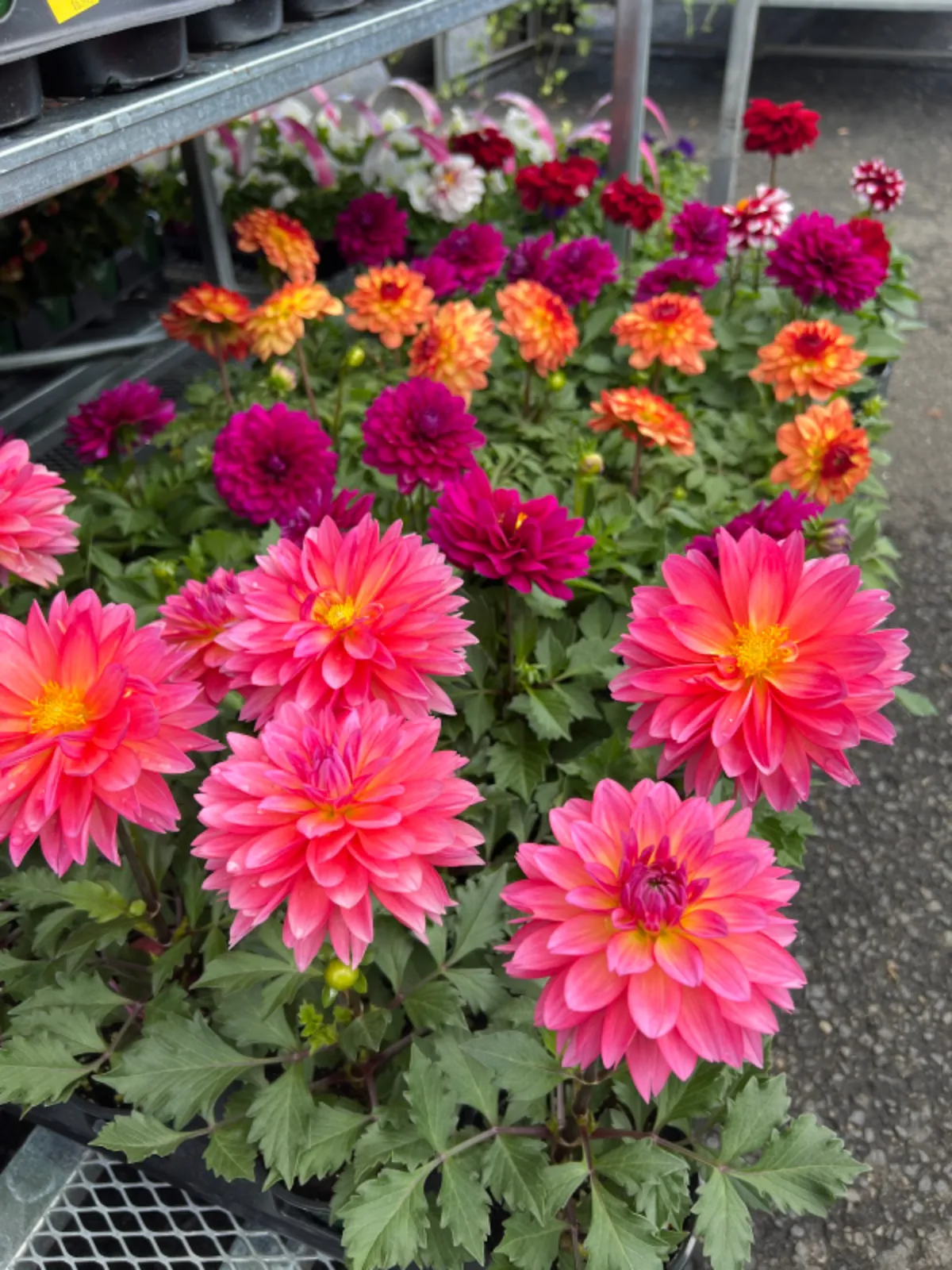Garden Center & Plant Nursery In Saddle Brook & Paramus NJ
Shop Online Pick-up in Store!
Gardening Tips & Insights from Your Trusted Garden Center In Paramus NJ
Explore Our Articles for Expert Advice on Gardening and Landscaping

The Ultimate Guide to Dahlia Care: Everything You Need to Know
The Ultimate Guide to Dahlia Care: Tips for Vibrant Blooms
About Dahlia Flowers
Dahlias are one of the most captivating flowers you can grow, known for their vibrant colors, intricate petal structures, and wide range of sizes. These tuberous perennials hail from the high plains of Mexico and Central America, where they have been cultivated for centuries. Their stunning blooms can be found in virtually every color of the rainbow, except blue, and they come in a multitude of forms including single, double, pompom, cactus, and decorative.
One of the remarkable features of dahlias is their diversity. The blooms can range from small, 2-inch miniatures to giant, dinner-plate-sized flowers over 10 inches in diameter. This variety makes them incredibly versatile in the garden, suitable for borders, beds, containers, and even as cut flowers for stunning floral arrangements.
Dahlias thrive in well-drained soil with plenty of organic matter. They are sun-loving plants, requiring at least six to eight hours of direct sunlight each day to produce their best blooms. With proper care, dahlias can bloom from mid-summer through to the first frost, offering a long season of color and beauty.
In addition to their visual appeal, dahlias are relatively easy to grow and care for, making them a favorite among both novice and experienced gardeners. They can add a touch of elegance to formal garden designs, provide a burst of color in cottage gardens, or simply brighten up any garden space with their dazzling display of blooms. Whether you plant them in beds or containers, dahlias are sure to become a standout feature in your garden, enchanting everyone who sees them.
Are Dahlias Perennials or Annuals?
Dahlias are technically classified as perennials, which means they have the ability to live for more than two years. In their native habitat of Mexico and Central America, dahlias can grow and bloom year after year without much interruption. However, their perennial nature can be somewhat deceptive depending on the climate in which they are grown.
In regions with mild, frost-free winters, dahlias can be left in the ground and will return each year with minimal effort. In these climates, the tubers, which are the storage organs of the plant, remain dormant during the cooler months and then sprout again when temperatures rise.
However, in colder climates where the ground freezes during winter, dahlias face a significant challenge. The tubers are not frost-hardy and will be damaged or killed if left in frozen soil. For this reason, gardeners in these regions must treat dahlias as annuals unless they take steps to protect the tubers over winter. This involves digging up the tubers after the first frost, allowing them to dry, and then storing them in a cool, dry place such as a basement or garage until the next planting season.
Here are the steps for overwintering dahlia tubers in colder climates:
Digging Up Tubers:
After the first frost has blackened the foliage, carefully cut back the stems to about 6 inches above the ground.
Use a garden fork or spade to gently lift the tubers from the soil, being careful not to damage them.
Drying Tubers:
Shake off excess soil and allow the tubers to air dry for a few days in a frost-free location.
This helps prevent rot during storage.
Storing Tubers:
Once dry, place the tubers in a box filled with peat moss, sand, or sawdust.
Store the box in a cool (40-50°F), dark, and dry location until spring.
Replanting Tubers:
When the danger of frost has passed and the soil has warmed in spring, you can replant the tubers outdoors.
By following these steps, you can successfully grow dahlias as perennials, even in regions with harsh winters. This extra effort is well worth it for the reward of vibrant, beautiful blooms year after year.
In summary, while dahlias are inherently perennials, the way they are treated depends largely on the local climate. In colder regions, gardeners often treat them as annuals by replanting each spring after overwintering the tubers indoors. This adaptability makes dahlias a versatile and beloved choice for many gardeners around the world.
Planting
When to Plant Dahlias
Timing is crucial when planting dahlias to ensure they thrive and produce their stunning blooms. The best time to plant dahlias is in the spring, specifically after the danger of the last frost has passed. This is because dahlias are sensitive to frost and cold temperatures, which can damage or kill the tubers and young shoots.
Here’s a detailed guide on when and how to plant dahlias for optimal results:
1. Determine the Last Frost Date:
The last frost date varies depending on your location. Check your local frost dates to find the approximate time when the risk of frost has passed.
This information can typically be found through local gardening centers, extension services, or online gardening resources.
2. Soil Temperature:
Wait until the soil temperature has warmed to at least 60°F (15°C) before planting. Cold soil can delay growth and lead to tuber rot.
Use a soil thermometer to check the temperature if you’re unsure. Insert the thermometer about 4-6 inches into the soil for an accurate reading.
3. Preparing the Planting Site:
Choose a sunny location that receives at least 6-8 hours of direct sunlight per day. Dahlias thrive in full sun.
Ensure the soil is well-draining. Poorly draining soil can lead to waterlogged conditions, which can cause tuber rot. Amending the soil with organic matter such as compost can improve drainage and provide nutrients.
4. Planting the Tubers:
Dig a hole about 6-8 inches deep for each tuber. Space the holes 18-24 inches apart, depending on the variety, to give the plants room to grow and to ensure good air circulation.
Place the tuber in the hole with the "eye" or growth point facing upwards. If the tuber has sprouted, handle it gently to avoid breaking the new growth.
Cover the tuber with soil and water thoroughly. The tubers will start to produce roots and shoots once the soil warms up.
5. Staking:
If you’re planting tall dahlia varieties, it’s a good idea to install stakes or supports at planting time. This will prevent damage to the tubers later on.
As the plant grows, tie the stems loosely to the stakes to provide support, especially when the blooms become heavy.
6. Mulching:
Applying a layer of mulch around the base of the plants can help retain soil moisture, suppress weeds, and regulate soil temperature.
Organic mulches such as straw, bark chips, or compost work well.
7. Watering:
After planting, water the tubers deeply to settle the soil and eliminate air pockets.
Dahlias prefer consistent moisture but avoid overwatering, especially before the shoots appear above the ground.
Growing Dahlias in Containers
Dahlias are not only perfect for garden beds but also thrive exceptionally well in containers. Growing dahlias in containers can add a burst of color to patios, balconies, and small garden spaces. Here’s a comprehensive guide on how to grow and care for dahlias in containers:
1. Choosing the Right Container:
Size: Select a large container with a diameter of at least 12-14 inches and a depth of 12 inches or more. Larger varieties of dahlias, especially the dinner-plate types, may require even bigger containers.
Material: Containers can be made of plastic, clay, ceramic, or wood. Ensure the material you choose has good drainage properties.
Drainage: Ensure the container has drainage holes at the bottom to prevent waterlogging, which can lead to tuber rot.
2. Soil Mix:
Use a well-draining potting mix rich in organic matter. Avoid garden soil, as it can be too heavy and may not drain well in containers.
A mix of potting soil with added perlite or sand can improve drainage. Adding compost can provide necessary nutrients for the dahlias.
3. Planting the Tubers:
Fill the container with the potting mix, leaving about 4-6 inches from the top.
Place the dahlia tuber horizontally with the "eye" or sprout facing up. Cover with 3-4 inches of soil.
Water thoroughly after planting to settle the soil around the tuber.
4. Placement and Light:
Place the container in a location that receives at least 6-8 hours of direct sunlight daily. Dahlias thrive in full sun.
If moving the container is necessary, ensure it’s not too heavy to handle. Placing the container on a wheeled plant stand can make it easier to move around.
5. Watering:
Dahlias in containers require consistent moisture but avoid overwatering. Water the container when the top inch of soil feels dry.
Containers can dry out more quickly than garden beds, so monitor moisture levels regularly, especially during hot weather.
6. Fertilizing:
Use a balanced, water-soluble fertilizer every 3-4 weeks. A fertilizer with a ratio of 10-10-10 or 5-10-10 is suitable.
Avoid high-nitrogen fertilizers, as they can promote foliage growth at the expense of blooms.
7. Supporting the Plants:
Tall dahlia varieties may need staking to support their stems as they grow. Insert stakes at planting time to avoid damaging the tubers later.
Tie the stems to the stakes loosely with garden twine or plant ties to keep them upright.
8. Deadheading and Pruning:
Regularly remove spent blooms to encourage continuous flowering. Deadheading helps the plant direct its energy towards producing new flowers.
Prune any damaged or diseased foliage to maintain plant health.
9. Pest and Disease Management:
Check for common pests like aphids, spider mites, and slugs. Use insecticidal soap or neem oil to treat infestations.
Ensure good air circulation around the plant to prevent fungal diseases. Avoid overhead watering to keep foliage dry.
10. Overwintering:
In colder climates, you can either move the container indoors to a frost-free location or dig up the tubers for storage.
If storing the tubers, remove them from the container after the first frost, let them dry, and store them in peat moss or sawdust in a cool, dry place.
Readying for Summer
As summer approaches, prepare your dahlias for the growing season by checking stored tubers for any signs of rot and discarding any damaged ones. Replant healthy tubers after the last frost date and give them a good start with proper soil and nutrients.
Conclusion
With proper care, dahlias will reward you with spectacular blooms from mid-summer to the first frost. Enjoy the beauty and versatility of these amazing flowers in your garden!
Discover the enduring beauty of plants and flowers at Stone Brook Garden Center, where each piece is chosen for its freshness and vitality. From unique garden plants to stunning floral arrangements for any occasion, find the ideal way to express yourself through nature’s own artistry.
Contact Us
Stone Brook Garden Center & Landscape Supply
451 Market St, Saddle Brook, NJ 07663
Legal
Privacy Policy
Terms & Conditions
© Stone Brook Garden Center & Landscape Supply 2025
All Rights Reserved

